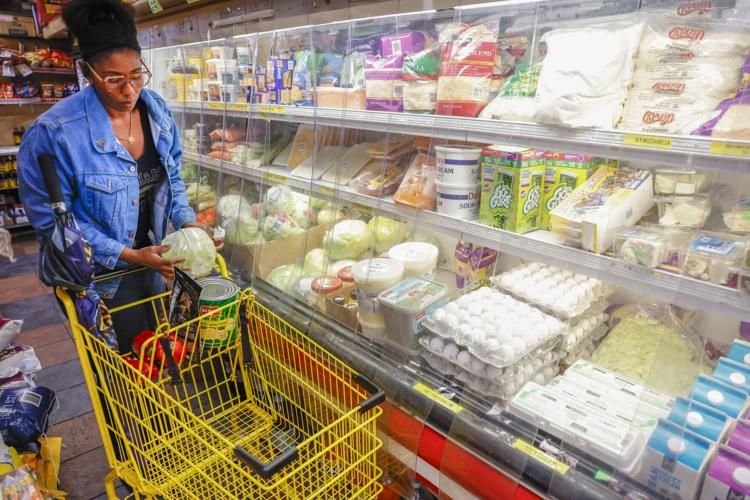
Read the full article at nola.com here.
The Lower 9th Ward hasn't had a grocery store in decades. New study gives some answers.
By JONI HESS | Staff writer
Sandwiched between the robust retail landscapes of St. Bernard Parish, the Marigny and the French Quarter, the Lower 9th Ward has struggled to attract traditional supermarkets and commercial investment in the two decades since the Industrial Canal wall failed during Hurricane Katrina, swamping homes and businesses.
The area is dotted with vacant storefronts, empty lots, gas stations and convenience stores, with two under construction and one in the planning stage.
About a third of its pre-Katrina population remains, according to The Data Center, and the city's zoning regulations haven't kept up.
But a new study spearheaded by the New Orleans Redevelopment Authority has shed light on what it would take to bring a grocery store to an area where more than half its landscape — 54% — is chronically vacant and only 2% dedicated to food and beverage outlets.
Some of the biggest obstacles are city zoning restrictions and an abundance of gas stations and convenience stores, according to the study compiled by economic development strategy group &Access.
NORA launched the St. Claude Retail Study in October with a $2 million allocation from the City Council, as part of a broader goal to revitalize the Lower 9th Ward and support small businesses primarily along the St. Claude Avenue corridor.
“This has been a longtime need,” said NORA board member Hattie Broussard during an April presentation of the study’s findings. “This is something that the community has wanted for a long time and no one else has gotten it done,” she said, crediting NORA for facilitating the project.
Long-term struggles
Despite ample vacant space, attracting grocers to the Lower 9th Ward is challenged by city zoning codes that restrict small businesses over 10,000 square feet, the study says.
Most grocers across New Orleans are near or past that size, such as locally owned Canseco's in nearby St. Bernard Parish at 11,600 square feet.
The area is zoned for dense residential communities and limits or prohibits certain commercial activities such as live performance venues, bars, fast-food restaurants, hotels and motels.
Establishments like gas stations, car washes and auto repair shops are allowed, but they are prohibited in the historic district along the upper stretch of St. Claude, which has seen a spate of new investment over the years including a full-service grocery store.
There, a bustling segment of bars, restaurants and entertainment venues are strung along a corridor in a neighborhood widely viewed as the flagship of post-Katrina gentrification.
The concentration of convenience and discount stores in the study area, especially those that appear to be in poor condition, can deter grocers from setting up shop, the study found. Prepackaged and shelf stable foods — a primary product line in such stores — make up some of the largest expenditures for supermarkets, making it difficult to compete in the same areas, &Access founder Bobby Boone said.
One option is to attract a store to a different major thoroughfare — Claiborne Avenue — where there are higher numbers of daily commuters and less crowding from convenience stores and other planned investments, the study showed.
Grassroots efforts
In the meantime, small businesses are trying to fill in the gaps, such as Sankofa Fresh Start Market on the corner of Forstall Street and St. Claude.
Sankofa Community Development founder Rashida Ferdinand started the nonprofit in 2008 to help restore the area after Katrina by way of fresh food access and environmental initiatives.
The market opened in September, an outgrowth of the open-air produce stand the organization has had since 2017. The market is filled with locally grown fruits and vegetables, grains, dried foods and other food staples.
Ferdinand has said the market's intent, in addition to offering healthy food access, is to inspire the return of businesses on St. Claude.
But other challenges remain.
Residents on both sides of the canal are battling plans for a grain terminal that would activate a rail line through neighborhoods. They say the "grain train" project poses health risks from polluted air and threatens further population loss and economic divestment.
A nearly $5 million federal project to replace the lock on the Industrial Canal has also stirred controversy and strong opposition from those who fear it will bring years of construction noise and lead to displacement and environmental disruption with little benefit to residents.
But the demand for grocery and retail options remains strong among residents who have long been vocal about the community's needs.
Officials are still exploring the potential of Claiborne Avenue as the best place for a full-service grocery. Study analysts estimate construction costs around $3 million, with $1.4 million in remaining funds from the City Council's allocation going toward the project.
